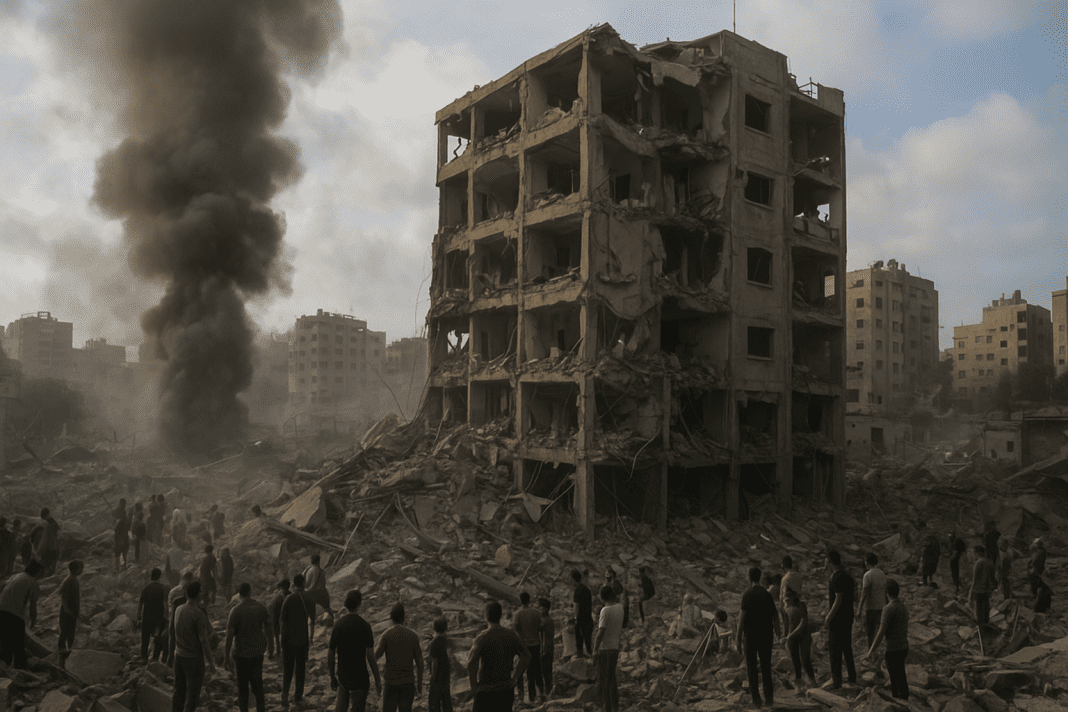In the latest escalation of the conflict, Mushta Tower, a large residential building in western Gaza City, was struck and destroyed. The tower was not just a building made of stone and concrete—it had become a shelter for hundreds of families who had already lost their homes in earlier attacks.
Mushta Tower Hit in Western Gaza City
Eyewitnesses described the strike on Mushta Tower as devastating. The explosion shook the entire neighborhood, and within moments, multiple floors of the high-rise collapsed. Thick black smoke rose into the sky, covering the surrounding streets and creating panic among nearby residents. The sound of the blast was heard across Gaza City.
The destruction left behind piles of rubble, with broken concrete, shattered glass, and twisted steel scattered everywhere. Personal belongings like clothing, toys, and furniture were thrown into the streets. For the families living there, this strike meant losing not only their temporary shelter but also the little they had managed to save from previous displacements.
The tower had been one of the few remaining shelters for people who had no other place to go. Many families were forced to flee once again, carrying nothing but what they could hold in their hands. Some had already been displaced multiple times, moving from one damaged area to another in search of safety.
Families Caught in the Mushta Tower Attack
Mushta Tower had become a refuge for families from across Gaza. Parents, children, and older residents had all gathered under its roof, hoping that the building would provide at least some form of protection. They believed the high-rise structure would be safer than smaller homes already destroyed in earlier airstrikes.
When the strike happened, the scene was filled with chaos. Families rushed down the staircases in panic, trying to escape the collapsing building. Parents carried their children in their arms, while others tried to help relatives who could not move quickly. Witnesses described people crying out, calling the names of their loved ones in the dust-filled air.
Rescue teams and local volunteers reached the site soon after the strike. They tried to clear heavy rubble with bare hands and simple tools to search for survivors. Cries for help were heard from under the debris, but the scale of the destruction made the rescue efforts extremely difficult. Every minute that passed made it harder to reach those trapped inside.
For many children, Mushta Tower had been a place where they could feel somewhat safe. Families had tried to create a sense of normal life inside the building by sharing food, sleeping close together, and helping one another. But within a few minutes, the tower was reduced to ruins. Schoolbooks, toys, and family photos were buried beneath the rubble, erasing what little normalcy they had managed to hold onto.
Widespread Damage Across Gaza City
The strike on Mushta Tower was part of a larger wave of attacks across Gaza City. During the same hours, airstrikes and artillery fire struck several neighborhoods. Smoke rose from different areas, and explosions echoed throughout the city.
In addition to hitting the tower, the strikes also damaged residential areas and refugee camps. Reports confirmed that the attacks destroyed several houses, killing residents and injuring many others. Ambulances carried the wounded from multiple strike sites, overwhelming hospitals in Gaza City. Medical staff, already working with limited resources, struggled to keep up with the flow of injured people.
The Israeli military also carried out large-scale demolitions in northern parts of Gaza City, bringing down apartment blocks in several neighborhoods. These demolitions left hundreds of families without homes, adding to the already massive displacement crisis.
Gaza for Sale? U.S. May Trade Frozen Libyan Funds for Relocation of Over 1 Million Palestinians
Humanitarian organizations described the living conditions as extremely harsh. Food supplies are running low, clean water is scarce, and electricity is almost nonexistent in many areas. Families move constantly in search of shelter, but with buildings like Mushta Tower destroyed, their options are shrinking rapidly.
The strike has highlighted once again the heavy cost of the conflict on ordinary people. For the hundreds of families who once called Mushta Tower their home, the attack left them without shelter, without safety, and without the little belongings they had managed to keep.

